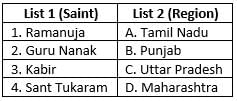History: CUET Mock Test - 5 - CUET MCQ
30 Questions MCQ Test - History: CUET Mock Test - 5
In 1875, a report on Harappan seal was published, which was written by
Direction: Answer the following questions by selecting the correct / most appropriate options.
Statement A): Raziya changed her name on her inscriptions and pretended she was a man.
Statement B): Authors of tawarikhs used social and gender differences to argue that men are superior to women.
Match List - I with List - II.

Choose the correct answer from the options given below:

How did Ashoka spread Buddhist ideals internationally?
Which ruler was in power when Ibn Battuta visited India?
Which feature of Indian cities did Ibn Battuta find remarkable?
What role did Ibn Battuta serve under Muhammad bin Tughlaq?
What aspect of Indian infrastructure did Ibn Battuta admire?
Match the terms with their meanings as described by travelers

Match the terms with their meanings in Bhakti tradition

Which of the following statements are correct?
(A) The Great Bath at Mohenjodaro was likely used for ritualistic bathing.
(B) Harappan seals were primarily made of iron and copper.
(C) The script of the Harappan civilization has been deciphered.
(D) The Harappan civilization flourished around 2500 BCE.
(E) Harappan cities had an advanced drainage system.
Choose the correct answer from the options given below:
Which of the following statements about Harappan trade are correct?
(A) The Harappans traded with Mesopotamia.
(B) Barter was the primary method of trade.
(C) The dockyard at Lothal was used for maritime trade.
(D) Harappan traders used gold coins for transactions.
(E) Trade goods included cotton, beads, and semi-precious stones.
Choose the correct answer from the options given below:
Which of the following statements about Harappan society are correct?
(A) Harappan houses were uniform in size and design.
(B) Social stratification is evident from house sizes.
(C) The Harappans worshipped a male god similar to Shiva.
(D) There were no signs of fortifications in Harappan cities.
(E) The Harappans practiced agriculture and domesticated animals.
Choose the correct answer from the options given below:
Which of the following statements regarding Harappan artifacts are correct?
(A) Harappan pottery was plain and undecorated.
(B) Seals were used for trade and administration.
(C) Bronze tools and weapons were commonly found.
(D) Terracotta figurines were made for religious purposes.
(E) Cotton was cultivated by Harappans.
Choose the correct answer from the options given below:
Who cultivated a large part of the land Jotedars acquired?
Who said that the English "played their game under cover of safeguards"?
What was the name of the non-violent protest that Gandhi first forged?
















